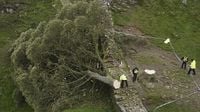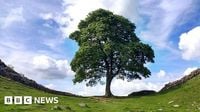In a case that has captured the hearts and minds of many, two men were found guilty on Friday of cutting down the iconic Sycamore Gap tree, a beloved landmark in northern England. Daniel Graham, 39, and Adam Carruthers, 33, were convicted by a jury at Newcastle Crown Court of criminal damage for felling the tree and damaging Hadrian's Wall, a UNESCO World Heritage site, on September 28, 2023.
The Sycamore Gap tree had stood for nearly 200 years along the ancient Hadrian's Wall, a remnant of the Roman Empire, and was cherished for its picturesque setting. It gained international fame when it appeared in Kevin Costner's 1991 film "Robin Hood: Prince of Thieves" and was voted "English Tree of the Year" in 2016. The loss of this landmark sent shockwaves through the community and beyond, provoking a widespread outpouring of grief and anger.
During the trial, the prosecution described the felling of the tree as a "deliberate and mindless act of destruction." Prosecutor Richard Wright KC detailed how Graham and Carruthers drove 30 miles at night to reach the tree, with one using a chainsaw to cut it down while the other filmed the act. The entire incident was over in just under three minutes, resulting in an estimated £622,191 (approximately $826,000) in damage to the tree and £1,144 (around $1,500) to Hadrian's Wall.
"For over a century, Sycamore Gap has been an iconic natural landmark in the northeast of England, bringing immeasurable joy to those visiting the area," said Gale Gilchrist, chief prosecutor for the region, after the verdict. "In just under three minutes, Graham and Carruthers ended its historic legacy in a deliberate and mindless act of destruction."
On the day of the incident, park ranger Gary Pickles received a call from a farmer reporting that the tree had been felled. Initially skeptical, he rushed to the scene and was met with shock and disbelief as he saw the beloved tree lying on its side. "It was a landmark. It's a piece of the landscape," he reflected. His initial assumption was that the tree had fallen due to inclement weather, but upon closer inspection, he confirmed it had been cut down deliberately.
As news of the incident spread, it quickly became a global story. Andrew Poad, general manager of the National Trust, described the moment he learned about the tree's fate as akin to losing a loved one. "It was like ringing people up to tell them that someone had passed away," he said. "We all went through that grief." Viral images of the fallen tree circulated on social media, drawing attention from around the world.
Following the verdict, Justice Christina Lambert ordered both men to remain in custody until their sentencing, scheduled for July 15, 2025. She warned that they could face a lengthy period of imprisonment, as the maximum sentence for criminal damage is ten years. The court heard that the defendants had previously been close friends, but their relationship had since deteriorated, with each blaming the other for the crime.
During the trial, Graham claimed that Carruthers had expressed a fascination with the tree and had made comments about cutting it down in jest. Carruthers, however, dismissed the significance of the tree, stating it was "just a tree" and failing to comprehend the public outcry. His remarks only fueled the anger directed at the pair, as many struggled to understand the motivation behind such a senseless act.
The public reaction to the felling was immense, with many expressing their sorrow and disbelief. Northumbria Police and Crime Commissioner Susan Dungworth stated that the act generated outrage and upset among people who had taken the iconic tree to heart. She emphasized the importance of bringing the perpetrators to justice, stating, "There was no remorse, but there was compelling evidence, and now there will be justice."
In the wake of the tree's destruction, the National Trust announced plans to grow seedlings from the original tree, with 49 saplings to be distributed across the UK as part of the "Trees of Hope" project. This initiative aims to create a lasting legacy for the Sycamore Gap tree, ensuring that its memory endures in communities throughout the country.
As the community mourns the loss of this cherished landmark, many are left wondering about the motivations behind the actions of Graham and Carruthers. The prosecution suggested they may have seen it as a prank, failing to realize the gravity of their actions and the anger they would incite. Despite the lack of a clear motive, the impact of the felling was undeniable, resonating deeply with people both locally and globally.
The Sycamore Gap tree was more than just a tree; it was a symbol of the natural beauty and heritage of the region. Its loss has left a significant gap in the landscape and in the hearts of many. As the sentencing date approaches, the community continues to reflect on the senseless act of vandalism that has forever altered their beloved landscape.
In a world where nature is often taken for granted, the tragic fate of the Sycamore Gap tree serves as a poignant reminder of the need to protect and cherish our natural heritage. The outrage and grief expressed by the public highlight the deep connections people have with nature and the importance of preserving such landmarks for future generations.





